J&D Manufacturing PSC Square Mounting Inflation Blower Motor with Louver, 148 CFM - Single Phase - With Cord Questions & Answers
Q: What is the purpose of ventilation?
A: Ventilation helps to maintain a healthy environment by regulating moisture and humidity, controlling temperatures, removing fumes and odors, and exchanging fresh air for humans and animals to maximize productivity.
Q: How does heat stress effect animals?
A: Heat stress in animals is a very serious condition that can lead to a decrease in appetite, loss of milk or egg production, shutdown of the reproduction system, diminished nutrient absorption, poor growth and even death in extreme cases.
Q: What should I consider when buying a ventilation fan?
A: There are many important factors to consider when purchasing a fan. Besides cost, you should also consider the efficiency of the fan, the noise level, and the energy use. Many ventilation fans have a lower upfront price tag, but will cost you more over time by consuming large amounts of energy.
Q: What type of ventilation system is available for my dairy farm?
A: J&D has numerous options for your dairy ventilation system including natural, recirculation, tunnel, and cross-tunnel ventilation. In addition to these basic ventilation types, evaporative pad cooling, soaking, misting, fogging and mechanical ventilation can all be intermixed to maximize the cooling capacity of your system.
Q: What is natural ventilation?
A: A Natural Ventilation System relies only on wind to cool your barn using open side walls or curtain side walls.
Advantages: low investment cost, low electrical operating cost, zero fan noise, easy management and operation, bright and airy work space, animals will not be affected by power failures.
Disadvantages: little to no temperature and air exchange control, no insect control, radiant sun increases temperature on outside stalls, precise building location is required to maximize wind direction.
Q: What is tunnel ventilation?
A: A Tunnel Ventilation System uses a series of exhaust fans on the short end of your building with inlets located on the opposite end. Air enters the building through the inlets where it is pulled down the length of your building like a wind tunnel and exhausted out the opposite end. The exhaust fans create air exchange and a high velocity air movement.
Advantages: insect control, consistent environment, proper temperature, humidity and odor control, keeps bedding and floors dry.
Disadvantages: higher investment cost when compared to natural ventilation, very little natural light, not suitable for year round use without a fresh air system due to inadequate fresh air distribution during cool winter ventilation conditions.
Q: What is cross-tunnel ventilation?
A: Cross Tunnel Ventilation is very similar to Tunnel Ventilation whereas a series of exhaust fans and inlets are used on the walls of your building. With Cross Tunnel Ventilation, the exhaust fans and inlets are located on the long sides of your building instead of the short sides. The air is pulled through the width of your building instead of through the length like it is with regular Tunnel Ventilation.
Advantages: building ends can be used for necessary overhead doors, insect control, consistent environment, proper temperature, humidity and odor control, keeps bedding and floors dry.
Disadvantages: higher investment cost when compared to natural ventilation, very little natural light, not suitable for year round use due to inadequate fresh air distribution during cool winter ventilation conditions.
Q: What is recirculation ventilation?
A: Recirculation Ventilation uses a series of recirculation fans that are positioned to blow air across the animals to create a cooling effect. When designed properly with an open or curtain side wall, you can also get an air exchange in the building.
Advantages: insect control, consistent environment, proper temperature, humidity and odor control, keeps bedding and floors dry
Disadvantages: higher installation and operating costs when compared to natural ventilation
Q: How do I know which ventilation system is best for me?
A: Selecting a ventilation system depends on a number of factors including budget, building location and orientation, and your complete ventilation strategy. Call our ventilation experts at 1-800-998-2398 or e-mail us at jdmfg@jdmfg.com to help design the best system for you.
Q: How do you size a building for proper ventilation?
A: J&D has knowledgable Engineering and Sales staff that can assist you in this process. We will design and recommend options to give you the most effective system. Call our ventilation experts at 1-800-998-2398 or e-mail us at jdmfg@jdmfg.com to help design the best system for you.
Q: How do I properly maintain my ventilation fan to improve efficiency and increase the lifespan?
A: All fans should be cleaned regularly by removing accumulated dirt and debris on louvers, blades and motors to improve performance. Dirt that clogs your fan motor will cause it to run hot, and will reduce the life of your motor. You should also regularly check fan belts and keep them adjusted to factory specifications. Loose belts can cause belt slippage and will reduce the airflow of your fan.
Q: When is the right time to add a cooling system to my ventilation system?
A: J&D recommends a cooling system when temperatures reach between 85° - 90° depending on your application.
Q: Why use a ceiling fan?
A: In the summer, a ceiling fan creates a mild wind chill to help cool the building. In the winter, a ceiling fan helps to mix the warm air that collects on the ceiling and in the peaks of most industrial and commercial buildings. By installing a ceiling fan, the warm air is recirculated back down to the floor level to help maintain a uniform temperature and save on heating costs.
Q: How close together should I install my ceiling fans?
A: For preventing heat stratification, it will be depend on the height of the ceiling. With ceilings between 15' and 30', ceiling fans should be mounted to cover 4000 square feet of floor area. For cooling people during the hot summer months, fans should be placed 15' to 20' apart.
Q: How do I wire my ventilation motor?
A: J&D recommends having all electrical work performed by a certified electrician. The electrician can find the wiring diagram on the motor label.
A: J&D offers a 2 year replacement warranty on all electric fan motors, unlike many of our competitors who offer only a one year warranty. Warranty is based on invoice date to the dealer, J&D does not cover freight or labor. POW14, POW18, POW18B, POW24OSC, POW30OSC, VBM60PSC-P, VBM148PSC-P, PDF24, and VRSM10-Power inlet motor carry a 1 year warranty. VR3E and VR33 motors (Mega Storm Fan) carry a 3 year warranty.

